Mikayla Peak
BLOG 06
Monday 16th September
Context
This week marked an important milestone as I prepared for my client pitch with Diversity Works NZ. My goal was to present my AI Roadmap Toolkit in a way that would resonate with their team and demonstrate its relevance and adaptability.
To focus my project and tailor it to the client’s needs, I developed detailed user personas based on the Tech Positionality Matrix I had previously created. These personas represent key stakeholders who might engage with the toolkit, each with unique challenges and goals:
- Jan, the Overworked Leader: Struggling to balance new tech adoption with existing tasks, Jan needs a manageable solution that aligns with organisational goals without overwhelming her.
- Phyllis, the Late-Career Learner: Phyllis feels left behind by advancing technology and needs a solution that boosts her confidence and helps her adapt without the fear of being replaced.
- Ryan, the Tech-Savvy Graduate: Always on the lookout for the latest innovations, Ryan is excited about AI but needs guidance on how to integrate it effectively within his organisation.
- Dwight, the Cautious Executive: Dwight is experienced and wary of the risks AI might pose. He seeks assurance that any new tech aligns with ethical standards and organisational values.
These personas helped me refine the pitch, ensuring that the toolkit addresses diverse needs and pain points. The challenge of fitting everything into a two-minute pitch led me to think strategically about how to structure my presentation and engage the client effectively.
Action

With these personas in mind, I created slides and notes for my presentation, highlighting the key features of the toolkit in a clear, concise way. Recognising the time constraints of a two-minute pitch, I also printed the toolkit as a booklet for the client to read through as I presented. This was my way of ensuring they had access to the depth of the toolkit without overwhelming them during the short pitch itself.
The presentation included an overview of the toolkit’s three phases—Foundations, Piloting, and Implementation—while also focusing on how it can support Diversity Works NZ in their mission of fostering more equitable workplaces. I kept the slides simple but impactful, ensuring that my visuals supported the core message without distracting from the main points.
Result

The preparation helped me focus on the key strengths of the toolkit, making sure that I didn’t get lost in the details. Having the user personas defined was incredibly helpful in shaping the narrative of the presentation, allowing me to show how the toolkit is adaptable to different organisational needs
By providing the client with a printed copy of the toolkit, I was able to balance the brevity of the pitch with the depth of the material, ensuring they could explore the toolkit in their own time after the presentation. This strategy worked well, as it allowed me to concentrate on the essentials during the pitch while giving the client a clear takeaway to refer back to later.
Learnings
A key learning from this week was how crucial it is to communicate the value of a project within tight time constraints. Developing the pitch helped me summarise the main features of the toolkit and articulate its relevance to different user groups. I realised that while the toolkit is comprehensive, the way it is communicated needs to be equally focused and easy to digest.
Working with the personas was a valuable exercise in refining the toolkit’s usability, and it reinforced the importance of tailoring solutions to the specific needs of each organisation or stakeholder. Additionally, pitching with a supporting document (the booklet) helped manage the challenge of fitting everything into a short timeframe without losing the breadth of the material.
With the client pitch complete, my next steps will involve reflecting on feedback from Diversity Works NZ, and my tutor, to further refine the toolkit. Additionally, I plan to explore more ways of presenting the toolkit to different audiences, ensuring that it remains flexible and responsive to varying organisational needs, especially as I work towards the final exhibition.